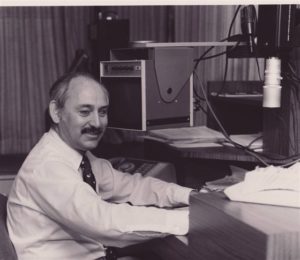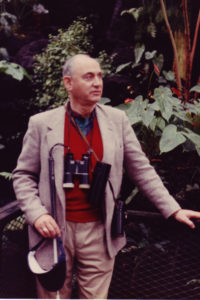In Memoriam:
Dr. Sam Genensky
by Joyce Kleiber
Dr. Samuel M. Genensky, founding president of CCLVI, died on June 26, 2009 at age 81. Dr. Genensky was a Rand Corporation mathematician and inventor of the closed circuit TV. In 1978 he founded the Center for the Partially Sighted, the first full service agency of its kind, based in Los Angeles. American Foundation for the Blind president Carl Augusto said, “Sam was responsible for really bringing low vision into the mainstream.” Sam Genensky cared enough about people with low vision that he put energy into founding CCLVI.

Sam Genensky strongly believed in the importance of using whatever vision he had. His eyes were burned shortly after birth when, by accident, the wrong eye drops to guard against infection were administered to his eyes. No sight remained in his left eye and he had only 20/1000 vision in his right eye.
Sam worked hard and he was exceptionally bright. He completed the first eight years of school in seven years. Then he was sent to the Perkins Institute for the Blind in Watertown Massachusetts where he refused to use braille even though he knew it. He preferred to use what little sight he had, even if it meant holding a book up to his nose.
Frustrated by teachers’ demands that he “act like a well-behaved blind child,” Sam left Perkins for a regular public high school in New Bedford. One day he took his father’s World War I-era binoculars to geometry class and was delighted to discover that he could see what the teacher was drawing on the board.
With the help of a doctor, he added another lens to one side of the binoculars, essentially creating a bifocal system that allowed him to read the blackboard in the distance as well as the book on his desk. He began to earn A’s.
After completing high school, Sam attended Brown University where he graduated magna cum laude in 1949 with a bachelor’s degree in physics. He earned a master’s in pure mathematics from Harvard in 1951 and a doctorate in applied mathematics from Brown in 1958.

In the late 1950s, Sam joined the Rand Corporation in Santa Monica, California. There he programmed early computers and modeled fluid dynamics and spontaneous combustion. A colleague, Paul Baran, noticed how Genensky had to work slumped over his drawing board with his nose to the paper. Baran suggested that there had to be a way to improve the mathematician’s ability to see.
With Baran and other scientists and engineers, Genensky hooked up a closed-circuit TV with a camera. It not only magnified the type on a page but had controls for brightness and contrast. Genensky didn’t have to slump over his desk anymore.
When the device was publicized as “Sam Genensky’s Marvelous Seeing Machine” in a 1971 issue of Reader’s Digest, the Rand mathematician was flooded with thousands of requests a week from people with partial sight who wanted to try it. Many of them said the magnifying machine enabled them to read printed matter for the first time. “The technology had a dramatic impact,” says Mitch Pomerantz, president of the American Council of the Blind. “Up until then, people with low vision had no alternatives, except perhaps magnifying glasses, and they were clunky.” Recalling his decision to devote himself to working for people who are partially sighted, Sam said, “I couldn’t turn my back on them. When the partially blind went out in the world, they found that they either got no services at all or services that were appropriate for people who were totally blind. Neither of these alternatives made much sense to me.”
During his two decades at Rand, Sam also introduced easy to read markings for men’s and women’s restrooms-a triangle for men and a circle for women. These symbols have been the standard for all public restrooms in the state of California.
Dr. Genensky traveled internationally to raise funds and bring attention to the cause of the partially sighted, and did some counseling himself. “Teenagers sometimes resisted help. They say, ‘I don’t want to use that. It looks funny!’ I say, I’m going to give you my ‘It’s fun to be different’ lecture.”
Dr. Genensky is survived by his second wife, Nancy Cronig, daughters Marsha and Judy, stepchildren Andrea Cronig Mindell, Mitchell Cronig and Adam Cronig, and four grandchildren. Memorial donations may be sent to the Center for the Partially Sighted, 12301 Wilshire Blvd., Los Angeles, CA 90025.
Learn More About the Award Program
Discover how Sam Genensky’s legacy lives on through CCLVI’s Dr. Samuel Genensky Memorial Magnification Award Program. Please click this link to learn about the award opportunities to assist individuals with low vision.